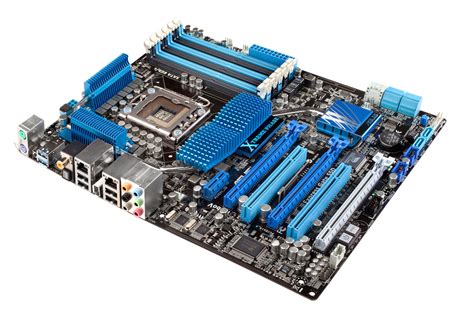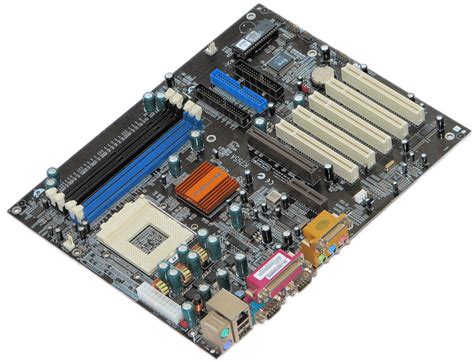Introduction to Mainboards
A mainboard, also known as a motherboard, is the primary printed Circuit board (PCB) found in computers and other electronic devices. It serves as the central hub that connects all the components of a system, allowing them to communicate and work together seamlessly. The mainboard is responsible for hosting the CPU, RAM, storage devices, expansion cards, and various other peripherals.
In this comprehensive article, we will dive deep into the world of mainboards, exploring their history, components, types, and their crucial role in modern computing.
The History of Mainboards
The concept of a mainboard can be traced back to the early days of computing. In the 1940s and 1950s, computers were massive, room-sized machines that utilized vacuum tubes and discrete components. As technology progressed, the need for a centralized circuit board became evident.
In the 1960s, the first true mainboards began to emerge. These early designs were simple, often featuring a single layer of copper traces and a handful of components. As integrated circuits (ICs) became more prevalent, mainboards evolved to accommodate these new technologies.
The 1980s saw the introduction of the first personal computers, which further popularized the use of mainboards. Companies like IBM and Apple began mass-producing computers with standardized mainboard designs, paving the way for the modern PC industry.
Mainboard Components
A typical mainboard consists of several key components that work together to ensure the proper functioning of a computer system. Let’s take a closer look at some of these essential elements:
1. CPU Socket
The CPU (Central Processing Unit) socket is the primary component on a mainboard. It is designed to house the processor, which acts as the brain of the computer. The socket type varies depending on the CPU architecture, such as Intel’s LGA (Land Grid Array) or AMD’s AM4 socket.
2. Chipset
The chipset is a set of integrated circuits that manage the flow of data between the CPU, RAM, storage devices, and other peripherals. It consists of two main components: the northbridge and the southbridge.
- The northbridge is responsible for communicating with the CPU, RAM, and graphics card.
- The southbridge handles input/output (I/O) functions, such as USB, SATA, and audio.
In modern mainboards, the northbridge and southbridge have been integrated into a single chip known as the Platform Controller Hub (PCH).
3. RAM Slots
Random Access Memory (RAM) slots are designed to hold memory modules that provide temporary storage for data and instructions currently in use by the CPU. The number of RAM slots varies depending on the mainboard, with most modern boards supporting dual-channel or quad-channel memory configurations.
4. Expansion Slots
Expansion slots allow users to add various peripherals and upgrade their system’s capabilities. Some common types of expansion slots include:
- PCI (Peripheral Component Interconnect): Used for sound cards, network adapters, and other legacy devices.
- PCI Express (PCIe): The most common expansion slot in modern mainboards, used for graphics cards, high-speed storage devices, and other high-bandwidth peripherals.
- M.2: A compact slot designed for solid-state drives (SSDs) and wireless networking cards.
5. Storage Connectors
Mainboards feature various storage connectors, allowing users to connect hard disk drives (HDDs), solid-state drives (SSDs), and optical drives. The most common types of storage connectors include:
- SATA (Serial ATA): The standard interface for connecting HDDs and SSDs.
- NVMe (Non-Volatile Memory Express): A high-speed interface for connecting PCIe-based SSDs.
6. Power Connectors
Power connectors on a mainboard are responsible for distributing electricity to the various components. The main power connectors include:
- 24-pin ATX: The primary power connector that supplies power to the mainboard.
- 8-pin CPU: Provides dedicated power to the processor.
- SATA power: Supplies power to SATA storage devices and optical drives.
7. I/O Ports
Input/Output (I/O) ports allow users to connect various peripherals to the computer. Some common I/O ports found on mainboards include:
- USB (Universal Serial Bus): Used for connecting keyboards, mice, external storage devices, and other peripherals.
- Ethernet: Enables wired network connectivity.
- Audio jacks: Provide connections for speakers, headphones, and microphones.
- Display outputs: Include VGA, DVI, HDMI, and DisplayPort for connecting monitors.

Mainboard Form Factors
Mainboards come in various sizes and shapes, known as form factors. The form factor determines the physical dimensions of the board and the placement of its components. Some common mainboard form factors include:
1. ATX
The ATX (Advanced Technology eXtended) form factor is the most popular choice for desktop computers. It measures 305 x 244 mm (12 x 9.6 inches) and offers a good balance between size and features.
2. Micro-ATX
Micro-ATX is a smaller version of the ATX form factor, measuring 244 x 244 mm (9.6 x 9.6 inches). It is ideal for compact computer cases and budget-friendly systems.
3. Mini-ITX
Mini-ITX is an even smaller form factor, measuring just 170 x 170 mm (6.7 x 6.7 inches). It is designed for small form factor (SFF) systems and home theater PCs (HTPCs).
4. E-ATX
The Extended ATX (E-ATX) form factor is larger than standard ATX, typically measuring 305 x 330 mm (12 x 13 inches). It is used in high-end workstations and gaming systems that require additional expansion slots and features.

Mainboard Chipsets and Sockets
Mainboard chipsets and sockets are crucial factors to consider when building or upgrading a computer system. The chipset determines the features and capabilities of the mainboard, while the socket type dictates which processors are compatible with the board.
Intel Chipsets
Intel offers a range of chipsets for its processors, each designed for specific market segments and feature sets. Some popular Intel chipsets include:
- Z-series: High-performance chipsets for enthusiasts and gamers, supporting overclocking and advanced features.
- H-series: Mainstream chipsets for general-purpose computing and productivity.
- B-series: Budget-friendly chipsets with basic features for entry-level systems.
AMD Chipsets
AMD also provides various chipsets for its processors, catering to different user needs and budgets. Some common AMD chipsets include:
- X-series: High-end chipsets for enthusiasts and gamers, offering extensive overclocking capabilities and premium features.
- B-series: Mainstream chipsets for general-purpose computing and gaming.
- A-series: Entry-level chipsets for budget-conscious users and basic systems.
CPU Sockets
CPU sockets are designed to be compatible with specific processor architectures. Some popular socket types include:
- LGA (Land Grid Array): Used by Intel processors, with pins on the socket and contact pads on the CPU.
- PGA (Pin Grid Array): Used by AMD processors, with pins on the CPU and holes on the socket.
- BGA (Ball Grid Array): A soldered connection typically used in mobile devices and embedded systems.
It is essential to ensure that the CPU socket on the mainboard matches the processor you intend to use. Compatibility information is readily available on manufacturer websites and in product specifications.

Mainboard Features and Technologies
Modern mainboards come equipped with a wide array of features and technologies designed to enhance performance, reliability, and user experience. Some notable features include:
1. UEFI BIOS
The Unified Extensible Firmware Interface (UEFI) is a modern replacement for the traditional BIOS (Basic Input/Output System). It offers a more user-friendly interface, faster boot times, and advanced features like secure boot and hardware-level security.
2. Overclocking Support
Enthusiast-grade mainboards often feature robust power delivery systems and comprehensive BIOS options for overclocking. These features allow users to push their CPUs and memory beyond stock speeds for improved performance.
3. RGB Lighting
Many modern mainboards incorporate RGB lighting, either through onboard LEDs or headers for connecting external RGB components. This allows users to customize the appearance of their systems and create unique lighting effects.
4. Wireless Connectivity
Some mainboards come with built-in wireless networking capabilities, such as Wi-Fi and Bluetooth. This eliminates the need for separate expansion cards and frees up PCIe slots for other devices.
5. Audio Enhancements
High-end mainboards often feature premium audio components, such as dedicated sound processors, high-quality capacitors, and shielded audio circuits. These enhancements provide improved sound quality for audiophiles and gamers.
6. Networking Features
Mainboards may include advanced networking features, such as Intel’s Ethernet Controller I225-V or Aquantia’s 10 Gigabit Ethernet controllers. These high-speed networking capabilities are essential for data-intensive tasks and online gaming.
Choosing the Right Mainboard
When selecting a mainboard for your computer system, there are several factors to consider:
-
Compatibility: Ensure that the mainboard is compatible with your chosen processor, RAM, and other components.
-
Form Factor: Choose a form factor that fits your computer case and meets your expansion needs.
-
Features: Consider the features that are important to you, such as overclocking support, wireless connectivity, or premium audio.
-
Budget: Determine your budget and select a mainboard that offers the best value for your money.
-
Brand and Quality: Opt for reputable brands known for producing high-quality mainboards with good customer support and warranty coverage.
By carefully evaluating these factors, you can select a mainboard that best suits your needs and provides a solid foundation for your computer system.
Conclusion
The mainboard is the backbone of any computer system, providing the essential connections and features that allow all components to work together seamlessly. As technology continues to advance, mainboards will evolve to accommodate new processors, memory standards, and expansion capabilities.
By understanding the components, form factors, chipsets, and features of mainboards, you can make informed decisions when building or upgrading your computer system. Whether you’re a casual user, a gamer, or a professional, selecting the right mainboard is crucial to ensuring optimal performance and reliability.
Frequently Asked Questions (FAQ)
- What is the difference between a mainboard and a motherboard?
-
There is no difference between a mainboard and a motherboard. Both terms refer to the main printed circuit board in a computer system.
-
Can I upgrade my mainboard without replacing other components?
-
It depends on the compatibility of the new mainboard with your existing components. You may need to upgrade your CPU, RAM, and other parts to ensure compatibility with the new mainboard.
-
How can I tell if a mainboard is compatible with my processor?
-
Check the CPU socket type and chipset of the mainboard and compare it with the specifications of your processor. Refer to the manufacturer’s website or product documentation for compatibility information.
-
What should I do if my mainboard is not working properly?
-
First, ensure that all components are correctly seated and connected. Check for any visible damage or signs of overheating. If the issue persists, consult the manufacturer’s support resources or seek assistance from a professional technician.
-
How often should I replace my mainboard?
- Mainboards typically have a long lifespan and do not need to be replaced frequently. However, you may consider upgrading your mainboard when newer technologies and features become available, or if your current board no longer meets your performance needs.
| Component | Description |
|---|---|
| CPU Socket | Houses the processor and determines compatibility |
| Chipset | Manages data flow between components |
| RAM Slots | Hold memory modules for temporary data storage |
| Expansion Slots | Allow the addition of peripherals and upgrade options |
| Storage Connectors | Provide connections for hard drives, SSDs, and optical drives |
| Power Connectors | Distribute electricity to various components |
| I/O Ports | Enable the connection of external peripherals |
Table 1: Key components of a mainboard
| Form Factor | Dimensions (mm) | Description |
|---|---|---|
| ATX | 305 x 244 | Most common, balanced size and features |
| Micro-ATX | 244 x 244 | Smaller, suitable for compact cases |
| Mini-ITX | 170 x 170 | Smallest, for SFF systems and HTPCs |
| E-ATX | 305 x 330 | Larger, for high-end workstations/gaming |
Table 2: Common mainboard form factors and their characteristics

Leave a Reply